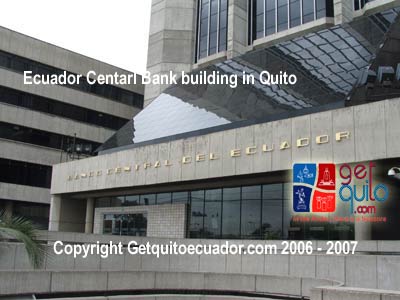|
Infrastructure
The government of Ecuador has been able to modernize the infrastructure of Ecuador and Quito as its capital with great benefits. Quito is a modern city with a great infrastructure of roads, houses, businesses and services for its inhabitants and visitors. The International Airport, Mariscal Sucre is located in the north of the city, where there are commercial centers, luxury hotels, buildings and companies giving the feeling of a metropolis of the new millennium.
Economy and society
The economic history of Quito has a total nexus with Ecuador. Ecuador has lived through the years, through stages crisis and of a booming economy. The great wealth of Ecuadorian soils produced products of quality for exporting like bananas, cacao and coffee. From there came the boom of Cacao, Banana pickers and oil left a lot of money that consequently were used wisely or poorly by the government.
The external debt, nevertheless, forgot about the social debt and for that reason some areas of the population live in extreme misery, due to the reduced hegemonic group, which continues to accumulate. Due to the banking crisis, the official currency, the Sucre, became the dollar.
The 9th of January 2005 marked the five-year anniversary of the dollarization in the country. In conclusion and looking back to 1999, where the most serious crisis of the last decade started, the dollarization was a positive move. The dollarization helped obtain an economic stability, lowered inflation and attracted investment. However, it also brought about other serious consequences to society, like a more expensive standard of living for everybody.
The capital of the country, since the beginning is Quito, is the center for political powers and the main financial groups. It also has the more important touristy zones and the famous Colonial area. The Historical Center contains beautiful churches, plazas and houses with an intriguing architecture, mainly, Baroque. The city is a metropolis that grows everyday, especially in the financial, cultural and touristy activities.
According to the Chamber of Commerce of Quito (2005), the official numbers of Quito referring to the social development indicate:
97% of the families have electric energy
87% have garbage removal
79% have sewage
71% have education
66% have housing
68% have health services
But besides the positive numbers in these services, it also shows:
9% indigency
33% poverty
4% illiteracy
The summary of the main preoccupations of the population of Quito is:
Public insecurity, pollution, unemployment, cleanliness, deforestation and informal and illegal work.
The economic indicators of the Chamber of Commerce of Quito also show:
Monthly Inflation
0,03 % (Jul 2006)
Annual Inflation
4 % (December 2005)
Risk of the Country
845 Points (January 2006)
International Monetary Reserve
1655,2 millions dollars (January 2006)
Price of oil
60 USD(January 2006)
INTEREST RATES
| BANKS |
ACTIVE |
|
PASSIVE |
|
| |
Corporative |
Consumption |
30 days |
90 days |
| Bolivariano |
11.00% |
14.00% |
2.25% |
3.50% |
| Pichincha |
12.00% |
14.66% |
2.00% |
2.75% |
| Produbanco |
14.00% |
14.66% |
2.25% |
3.50% |
| Pacifico |
12.50% |
14.50% |
2.25% |
2.50% |
| Guayaquil |
14.66% |
14.66% |
2.15% |
2.50% |
Sources:
Chamber of Commerce of Quito
Ecuador Central Bank
Investigation done by Get Quito Ecuador
|


